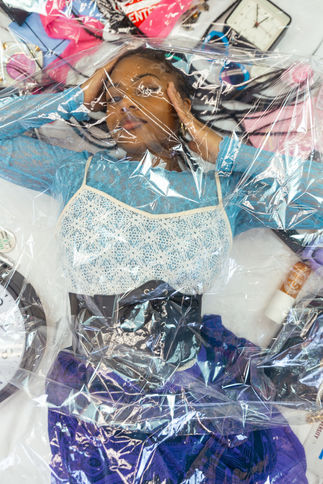Personality Interrupted
Photographed by Maddison Hill of Auset Pope, Olivia Schotthoefer, Piper Davis, and Taylor Horazy
Styled by Isabella DeMers
Directed by Jazmin Anderson
Hair & Makeup by Abigail Goodman
Stylist and Photographer assisted by Mary Germilhac
Maddison Hill
Are you a clean girl? Or are you a vanilla girl with a slick-back bun, gold hoops, beige clothes, and minimal makeup? Are you a pink Pilates princess, with leg warmers draped at your ankles and pink silky bows tied into your hair? Do you prefer the cottage core or coquette style? How about the mob wife, rock star girlfriend, coastal cowgirl, or electric grandpa styles? Are you “that’’ girl? Or are you an “it” girl?
Fashion trends have always impacted society. Trends change society and the way people dress. Trends have existed for decades. In the 1890s, trumpet-shaped skirts paired with tailored shirts with tight-fitting ruffled sleeves were popular. In the 1980s, neon-colored outfits, leg warmers, and big hair were trendy. In the early 2000s, low-rise jeans were all the rage.
Throughout the decades, styles were just fashion. This remained true until 2020. Since 2020, the internet has converted styles into aesthetics.
The aesthetics sold on the internet aren’t just clothing to wear but entire lifestyles. The aesthetics are promoted with a name, a look, and a vibe around it. The creators encouraging the aesthetic give you clothes to wear, music to listen to, and even tips on how to live your life according to the aesthetic.
Subcultures with aesthetics have always existed. However, prior to being classified as subcultures, these groups already had distinct characteristics with personalities.
Today, new subcultures emerge into the media as trends and create curated micro identities. These trends become marketable and quickly become detached from any authenticity.
Fashion has a tremendous impact on our identity and who we are as individuals. The clothes we wear and the accessories we choose communicate important messages about who we are and what we stand for. A simple outfit can affect our mood and confidence levels.
You can’t separate your personal style from your identity because they coexist. What happens when we build our entire persona based on a popular aesthetic?
Micro-identities can be isolating and harmful. We chase different identities in search of personality, identity, and belonging. However, as trends shift every four weeks, we quickly lose sight of what we’re chasing.
The constant change in styles and personal aesthetics is overwhelming. With access to so many trends, styles, and aesthetics, the line between personal identity and content is blurry.
To emulate the aesthetics showcased on social media, we consume. We buy new Lululemon and Alo workout sets to become the perfect pink Pilates princess. We buy every gold hoop on Amazon and spend hundreds on natural makeup to be the cleanest “clean girl.”
The pursuit of online aesthetics strips our individuality and creates constant social comparison.
In her song “pretty isn’t pretty,” on her sophomore album “Guts,” Olivia Rodrigo says, “I bought all the clothes that they told me to buy. I chased some dumb ideal my whole fucking life, and none of it matters.” This song touches on how we so desperately want to fit in somewhere and find our personality that we rush to current trends and grab hold of its personalities. But as Rodrigo said, none of it matters. A trendy personality will never make us feel whole, because an aesthetic is not who we are.
The more we find new personalities among trends, the less our actual personalities shine.
There is nothing wrong with trying out trends. A trend could even lead us to finding our personal style. Making our personality based on a trend is the problem.
The coolest, most fashionable people you know don’t follow aesthetics. They have a personal style based on what makes them feel comfortable and happy. They invest in themselves and don’t force their lifestyle and personality to look aesthetic.
Focusing only on aesthetics and having an aesthetic personality will eventually catch up to you, and you will have no idea who you are. You must work on yourself and find your personality. Establishing an identity beyond aesthetics is essential to learning who we are.
When we accept and love who we are, we don’t search for material items or new aesthetics to feel whole. When we break away from the constant consumption of new identities, we find our own personal identity.






